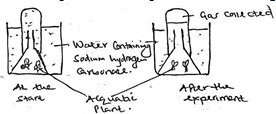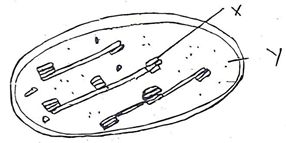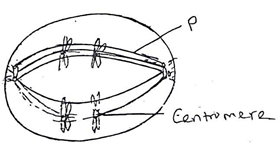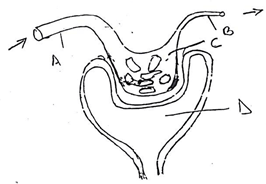BIOLOGY
PAPER 1
(THEORY)
FORM 4 TERM 1 OPENER EXAMS
TIME: 2 HOURS
INSTRUCTIONS TO CANDIDATES
- Answer all questions in the spaces provided.
- Give the structure of the cell that perform the following functions.
- Synthesis of ribosomes (1 mark)
- Regulate exchange of substance in and out of the nucleus. (1 mark)
- Breakdown large molecules and destroy worn out organelles (1 mark)
- State the name given to the study of:
- Insect (1 mark)
- The cell (1 marks)
-
- Name two raw materials for the dark stage process of photosynthesis (2 marks)
- The set up shows an experiment to investigate photosynthesis.
What gas was collected in the test tube? (1 mark)
- Give three structural features that reduce water loss from a leaf. (3 marks)
-
- Name the process that involved in the uptake of mineral salts from the soil by the plants. (1 mark)
- Explain what you understand by the term diffusion gradient. (1 mark)
-
- Define the term enzyme. (1 mark).
- Give one factor that affect the rate of enzyme activity. (1 mark)
-
- Name one defect of circulatory system in humans. (1 mark)
- State three functions of blood other than transport. (3 marks)
- State two ways in which floating leaves of aquatic plant are adapted for gaseous exchange (2 marks)
- List the changes that takes place during inhalation in the breathing cycle of mammal in the following
- Rib cage (2 marks)
- Diaphragm (1 mark)
- Study the word equation below:
Glucose → Ethanol +Cabon(iv)Oxide- Name the process shown in the equation above. (1 mark)
- Suggest the organism(s) in which it takes place. (1 mark)
- Give one application of the process in industry. (1 mark
- Name the substances that do not undergo digestion but are absorbed directly from the alimentary canal to the blood stream. (2 marks)
- Sate one use of each of the following plants excretory products.
- Tannins (1 mark)
- Colchicines (1 mark)
- Quinine (1 mark)
- The diagram below represent a cell organelle
- Name the part labeled Y. (1 mark)
- State the function of the part labeled X. (1 mark)
- The diagram below represents a stage during cell division.
- Identify the stage of cell division. (1 mark)
- Give two reasons for your answer in (a) above. (2 marks)
- Name the structure labeled P. (1 mark)
- State the importance of each of the following features of mammalian ileum.
- Highly coiled.(1 mark)
- Long (1 mark)
- The figure below illustrate a part of a kidney nephron.
- Name the parts labeled A and D (2 marks)
- State one observable difference between part A and B. (1 mark)
- Name two components found in A but absent in part D. (2 marks)
-
- Pregnancy continues if the ovary of an expectant mother is removed after the 4th month. Explain (2 marks)
- What is the role of testis in the mammalian reproductive system (2 marks)
-
- State three characteristics of monera that are not found in other kingdoms. (3 marks)
- Name the class to which a termite belong. (1 mark)
- The diagram below shows a pollen tube as it grows down the style.
- Name the part labeled M,N (2 marks)
- State the functions of the part labeled M . (2 marks)
- Below is a diagram of moss
- Classify the moss into kingdom and division (1 mark)
- State the function of the part labeled A (1 mark)
- State one function of the part labeled K (1 mark)
-
- What is metamorphosis? (1 mark)
- What is the biological importance of the larval stage during metamorphosis (2 marks)
- A plant stem was put in a solution. After 30 minutes a cell from the stem looked like the one drawn below;
- State the type of solution the stem was put in (1 mark)
- What term is used to describe the cell (1 mark)
- Explain what happened (2 marks)
-
- A student visiting a game park observed an adult elephant flapping its ears twice as much as its calf in order to cool its body when it is hot. Explain. (2 marks)
- Explain why some desert animas excrete uric acid rather than ammonia. (2 marks)
-
- What is seed dormancy? (1 mark)
- Name a growth inhibitor in seed. (1 mark)
- Differentiate between hypogeal and epigeal germination in seeds. (2 marks)
- Name the causative agent of the following diseases in man. (1 mark)
- Candidiasis (1 mark)
- Syphilis (1 mark)
- To establish the population of tilapia using the capture method, 60 fish were captured and released. In the second capture out of 72 fish, 10 had been marked. Calculate the estimated population of tilapia. (show your working) (2 marks)
MARKING SCHEME
- Give the structure of the cell that perform the following functions.
- Synthesis of ribosomes (1 mark)
- Nucleolus;
- Nucleolus;
- Regulate exchange of substance in and out of the nucleus. (1 mark)
- Nuclear membrane;
- Nuclear membrane;
- Breakdown large molecules and destroy worn out organelles (1 mark)
- Lysosome;
- Lysosome;
- Synthesis of ribosomes (1 mark)
- State the name given to the study of:
- Insect (1 mark)
- Entomology
- Entomology
- The cell (1 marks)
- Cytology
- Cytology
- Insect (1 mark)
-
- Name two raw materials for the dark stage process of photosynthesis (2 marks)
- Carbon(IV) oxide, hydrogen ions / atoms
- Carbon(IV) oxide, hydrogen ions / atoms
- The set up shows an experiment to investigate photosynthesis.
What gas was collected in the test tube? (1 mark)- Oxygen gas
- Oxygen gas
- Name two raw materials for the dark stage process of photosynthesis (2 marks)
- Give three structural features that reduce water loss from a leaf. (3 marks)
- Thick cuticle
- Stomata on lower side of the leaf
- Fewer stomata
- Small stomata pore
- Needle like leaves
-
- Name the process that involved in the uptake of mineral salts from the soil by the plants. (1 mark)
- Active transport / diffusion
- Active transport / diffusion
- Explain what you understand by the term diffusion gradient. (1 mark)
- Difference between number of molecules on the region of high concentration and the region of low concentration.
- Difference between number of molecules on the region of high concentration and the region of low concentration.
- Name the process that involved in the uptake of mineral salts from the soil by the plants. (1 mark)
-
- Define the term enzyme. (1 mark).
- An enzyme is a biological/organic catalyst that speeds up to slows down the rate of biochemical reactions in living organisms.
- An enzyme is a biological/organic catalyst that speeds up to slows down the rate of biochemical reactions in living organisms.
- Give one factor that affect the rate of enzyme activity. (1 mark)
- pH - substrate concentration - Temperature
- Enzyme concentration - co-factors and co-enzymes.
- Define the term enzyme. (1 mark).
-
- Name one defect of circulatory system in humans. (1 mark)
- Thrombosis
- Varicose veins
- Arteriosclerosis.
- Hypertension acc. high blood pressure.
- Cerebral/vascular/coronary thrombosis.
- State three functions of blood other than transport. (3 marks)
- Regulation of body temperature.
- Regulation of PH of body fluids.
- defences against diseases causing organism/ pathogens/infection.
- prevent excessive bleeding by enhancing clotting/prevent excessive loss of blood.
- Stomata are found on upper epidermis; for efficient gaseous exchange;
- Name one defect of circulatory system in humans. (1 mark)
- State two ways in which floating leaves of aquatic plant are adapted for gaseous exchange (2 marks)
- Presence of large air spaces/ aerenchyma tissues; to enable it float/ for buoyance;
- presence of large air spaces; for storage of air;
- List the changes that takes place during inhalation in the breathing cycle of mammal in the following
- Rib cage (2 marks)
- Rises upwards; and outwards;
- Rises upwards; and outwards;
- Diaphragm (1 mark)
- flattens
- flattens
- Rib cage (2 marks)
- Study the word equation below:
Glucose → Ethanol +Cabon(iv)Oxide- Name the process shown in the equation above. (1 mark)
- Anaerobic respiration
- Anaerobic respiration
- Suggest the organism(s) in which it takes place. (1 mark)
- Plants
- Plants
- Give one application of the process in industry. (1 mark)
- Baking of bread.
- brewing of alcohol.
- production of biogas and gasohol.
- manufacturing of dairy produces.
- treatment of sewage
- Production of silage.
- production of organic products e.g. citric acid.
- Name the process shown in the equation above. (1 mark)
- Name the substances that do not undergo digestion but are absorbed directly from the alimentary canal to the blood stream. (2 marks)
- Vitamins, minerals; water; rej cellulose/ roughage.
- Vitamins, minerals; water; rej cellulose/ roughage.
- State one use of each of the following plants excretory products.
- Tannins (1 mark)
- Treatment of leather
- Treatment of leather
- Colchicines (1 mark)
- causes polyploidy 1 mark
- used in treatment of cancer
- Quinine (1 mark)
- used as anti-malaria drugs
- used as anti-malaria drugs
- Tannins (1 mark)
- The diagram below represent a cell organelle
- Name the part labeled Y. (1 mark)
- Stroma
- Stroma
- State the function of the part labeled X. (1 mark)
- Provides a large surface area for maximum packages of chlorophyll hence photolysis/splitting of water molecule.
- Bearing photosynthetic pigments of chlorophyll molecules hence site for light dependent reaction, Where light is trapped for photolysis.
- Name the part labeled Y. (1 mark)
- The diagram below represents a stage during cell division.
- Identify the stage of cell division. (1 mark)
- Metaphase I
- Metaphase I
- Give two reasons for your answer in (a) above. (2 marks)
- Association of homologous chromosomes.
- Homologous chromosomes lie side by side on the equator of the spindle fibres
- Name the structure labeled P. (1 mark)
- P-spindle fibre
- P-spindle fibre
- Identify the stage of cell division. (1 mark)
- State the importance of each of the following features of mammalian ileum.
- Highly coiled.(1 mark)
- Slow down movement of food allowing time for digestion and absorption;/ be able to fit the abdominal cavity;
- Slow down movement of food allowing time for digestion and absorption;/ be able to fit the abdominal cavity;
- Long (1 mark)
- To increase surface area for maximum absorption of food;
- To increase surface area for maximum absorption of food;
- Highly coiled.(1 mark)
- The figure below illustrate a part of a kidney nephron.
- Name the parts labeled A and D (2 marks)
- A-Afferent arteriole
- D- Bowman’s capsule
- State one observable difference between part A and B. (1 mark)
- A-wider lumen
- B-narrow lumen 1mark
- Name two components found in A but absent in part D. (2 marks)
- Proteins
- Blood cells
- Name the parts labeled A and D (2 marks)
-
- Pregnancy continues if the ovary of an expectant mother is removed after the 4th month. Explain (2 marks)
- This is because the role of secreting progesterone which maintain pregnancy is taken over by the plaecenta ;
- This is because the role of secreting progesterone which maintain pregnancy is taken over by the plaecenta ;
- What is the role of testis in the mammalian reproductive system (2 marks)
- Production of sperms
- Pregnancy continues if the ovary of an expectant mother is removed after the 4th month. Explain (2 marks)
-
- State three characteristics of monera that are not found in other kingdoms. (3 marks)
- Have cell wall made of Murein
- Genetic/ nuclear material not surrounded by a nuclear membrane hence prokaryotic
- Lack most organelle/have few organelles/mitochondria absent.
- Name the class to which a termite belong. (1 mark)
- Class insecta
- Class insecta
- State three characteristics of monera that are not found in other kingdoms. (3 marks)
- The diagram below shows a pollen tube as it grows down the style.
- Name the part labeled M,N (2 marks)
- M-male nuclei
- N- Tube nucleus
- State the functions of the part labeled M . (2 marks)
- One of male nuclei fuse with egg cell to form a diploid zygote; the other male nucleus fuses with polar nuclei; to form a primary endosperm nucleus.
- One of male nuclei fuse with egg cell to form a diploid zygote; the other male nucleus fuses with polar nuclei; to form a primary endosperm nucleus.
- Name the part labeled M,N (2 marks)
- Below is a diagram of moss
- Classify the moss into kingdom and division (1 mark)
- Plantae (Reject small p)
- Bryophyta(Reject small b)
- State the function of the part labeled A (1 mark)
- Formation of spores 1 mark
- Formation of spores 1 mark
- State one function of the part labeled K (1 mark)
- Anchorage
- Absorption of water mineral salts
- Classify the moss into kingdom and division (1 mark)
-
- What is metamorphosis? (1 mark)
- Change in body form during the life cycle of an organism;
- Change in body form during the life cycle of an organism;
- What is the biological importance of the larval stage during metamorphosis (2 marks)
- In the larval stage there is vigorous feeding; hence the insect obtain enough nutrients/ food 2 marks
- In the larval stage there is vigorous feeding; hence the insect obtain enough nutrients/ food 2 marks
- What is metamorphosis? (1 mark)
- A plant stem was put in a solution. After 30 minutes a cell from the stem looked like the one drawn below;
- State the type of solution the stem was put in (1 mark)
- Hypertonic
- Hypertonic
- What term is used to describe the cell (1 mark)
- Plasmolysed cell
- Plasmolysed cell
- Explain what happened (2 marks)
- water molecules moved out of the cell by osmosis due to hypertonic solution therefore the cell membrane detached from the cell wall (2 marks)
- State the type of solution the stem was put in (1 mark)
-
- A student visiting a game park observed an adult elephant flapping its ears twice as much as its calf in order to cool its body when it is hot. Explain. (2 marks)
- The surface area to volume ratio is higher in calves; hence adults retain more heat than the calves hence need to have other ways to lose heat./ the surface area to volume ratio is lower in adults than in calves; hence calves lose more heat than adults.
- The surface area to volume ratio is higher in calves; hence adults retain more heat than the calves hence need to have other ways to lose heat./ the surface area to volume ratio is lower in adults than in calves; hence calves lose more heat than adults.
- Explain why some desert animals excrete uric acid rather than ammonia. (2 marks)
- Elimination of uric acid requires less water than ammonia, hence (more) water is conserved; uric acid is less toxic than ammonia hence safer to excrete where there is less water;
- Elimination of uric acid requires less water than ammonia, hence (more) water is conserved; uric acid is less toxic than ammonia hence safer to excrete where there is less water;
- A student visiting a game park observed an adult elephant flapping its ears twice as much as its calf in order to cool its body when it is hot. Explain. (2 marks)
-
- What is seed dormancy? (1 mark)
- Ability of a seed to retain viability while having restricted metabolic activity;/ state during which a viable seed cannot germinate when conditions are suitable;(1 mark)
- Ability of a seed to retain viability while having restricted metabolic activity;/ state during which a viable seed cannot germinate when conditions are suitable;(1 mark)
- Name a growth inhibitor in seed. (1 mark)
- Abscissic acid; (1mark)
- Abscissic acid; (1mark)
- Differentiate between hypogeal and epigeal germination in seeds. (2 marks)
- Epigeal-Cotyledons, brought above ground level; hypocotyl elongates faster while in Hypogeal cotyledons remain below ground level, epicotyl elongate faster 2 marks
- Epigeal-Cotyledons, brought above ground level; hypocotyl elongates faster while in Hypogeal cotyledons remain below ground level, epicotyl elongate faster 2 marks
- What is seed dormancy? (1 mark)
- Name the causative agent of the following diseases in man. (1 mark)
- Candidiasis (1 mark)
- Candida albicans
- Candida albicans
- Syphilis (1 mark)
- Treponema pallidum
- Treponema pallidum
- Candidiasis (1 mark)
- To establish the population of tilapia using the capture method, 60 fish were captured and released. In the second capture out of 72 fish, 10 had been marked. Calculate the estimated population of tilapia. (show your working) (2 marks)
- P=(fm×sc)/MR =(60×72)/10; 432 tilapi
Download Biology Paper 1 Questions and Answers - Form 4 Term 1 Opener Exams 2021.
Tap Here to Download for 50/-
Get on WhatsApp for 50/-
Why download?
- ✔ To read offline at any time.
- ✔ To Print at your convenience
- ✔ Share Easily with Friends / Students








